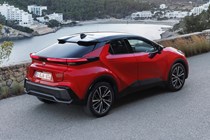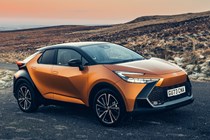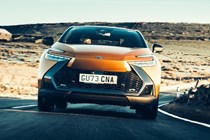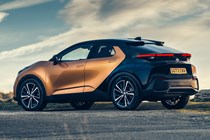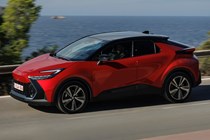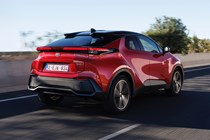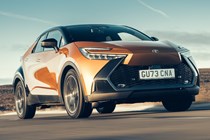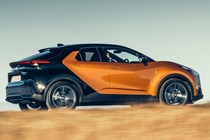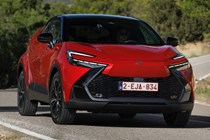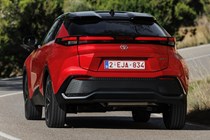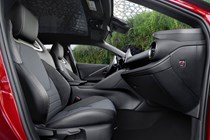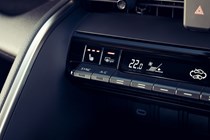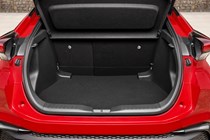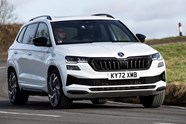Toyota C-HR review
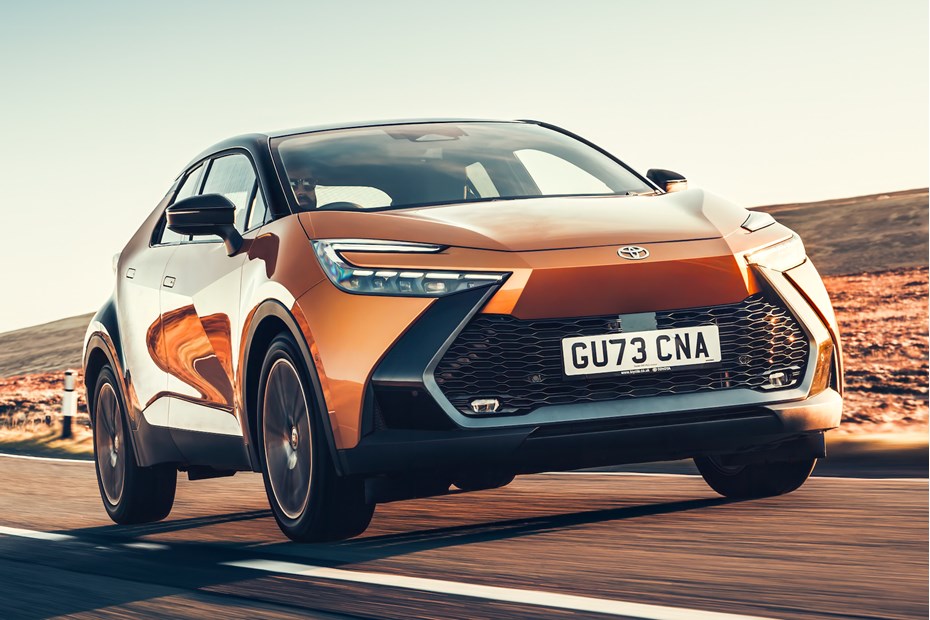
At a glance
| Price new | £31,645 - £47,095 |
|---|---|
| Used prices | £21,728 - £34,870 |
| Road tax cost | £195 - £620 |
| Insurance group | 20 - 29 |
Get an insurance quote with

|
|
| Fuel economy | 56.6 - 60.1 mpg |
| Miles per pound | 8.3 - 8.8 |
| Number of doors | 5 |
| View full specs for a specific version | |
Available fuel types
Hybrid
Pros & cons
- Efficient hybrid system
- Punchy PHEV performance
- Quality feel up front
- Not all that practical
- Rear quality well behind the front
- Not as dynamic as it looks
Toyota C-HR SUV rivals
Overview
Should you buy one?
That depends on what you’re using the Toyota C-HR for. If you fancy a distinctive and efficient SUV that’s easy to drive, we think it’s worth considering. That 50mpg real-world fuel economy figure and 10-year warranty are huge selling points.
Just don’t expect its driving experience to be anywhere near as interesting as its looks and, for the love of whatever deity you worship, spec it in a loud colour. Toyota does a range of wild two-tone paint finishes, including a pleasingly lairy orange and black ensemble. It’s worth the extra cash – the standard white paint finish is dull.
We’d also advise you to exercise caution when shopping for a C-HR for family duties. It’s spacious enough on paper, but that sloping roofline robs both rear headroom from lanky teenagers and loading height from any tall items you might need to carry in the boot. Like plants. Or lamps.
It’s a decent choice but, for the money, we think the Skoda Karoq is the better choice. It’s better to drive, it’s more practical (thanks to its conventionally shaped rear end) and it’s about £700 cheaper in its most basic specification. If you simply must have a coupe SUV, consider the Cupra Formentor.
What’s new?
This is the second generation of the rather popular Toyota C-HR, a hybrid-only SUV that puts style above space. With the addition of a plug-in hybrid powertrain for the first time, could this be one of the best hybrids out there?
It’s similar in size to a Skoda Karoq, although we’d argue more rakish alternatives are more natural rivals. This includes the Renault Arkana which is also available with hybrid power. Alternatively, there’s always the Cupra Formentor.
The C-HR isn’t available with quite as much power as the Formentor, and there isn’t the option of four-wheel drive in the UK. We get either a 140hp or 197hp self-charging hybrid, or the aforementioned plug-in hybrid. This ups power to 223hp and makes the acceleration brisk, if not outright fast. The PHEV’s claimed EV-only range is 41 miles giving CO2 emissions of 19-20g/km, which is good news for company car users.
With a new platform, the promise of a more upmarket interior and the latest generations of both its self-charging and plug-in hybrid powertrains, Toyota has taken a step forwards over the old C-HR. That’s especially true of the styling that’s even more extravagant than its predecessor.
The C-HR range kicks off with an entry-level Icon specification, which comes with automatic wipers, LED headlights with high beam assist, keyless entry and start, a reversing camera, climate control and 17-inch wheels.
Toyota reckons the Design model will be the biggest seller, so it comes with the equipment that most of its customers crave. This includes rear cross traffic alert with auto braking, front and rear parking sensors, ambient lighting, a rear USB port, a wireless phone charger, dual-zone climate control, 18-inch wheels and heated front seats amongst other things.
Step up another rung and you arrive at Toyota’s Excel trim. It’s geared towards luxury, so gets adaptive high beam, lane change assist, front cross traffic alert, a panoramic camera, synthetic leather and suede seats and a black roof.
At the top of the range, there’s the GR Sport spec. This adds 20-inch alloy wheels, two-tone paint, a head-up display, upgraded ambient lighting, a JBL stereo, Alcantara seats with electric driver’s adjustment and a noise reducing windscreen.
Click through the next few pages to read everything you need to know about the Toyota C-HR, including its practicality, how much it costs to run, what it’s like to drive – and whether we recommend buying one. If you’re interested in how we arrived at our decision on the C-HR, check out our how we test cars explainer page.



